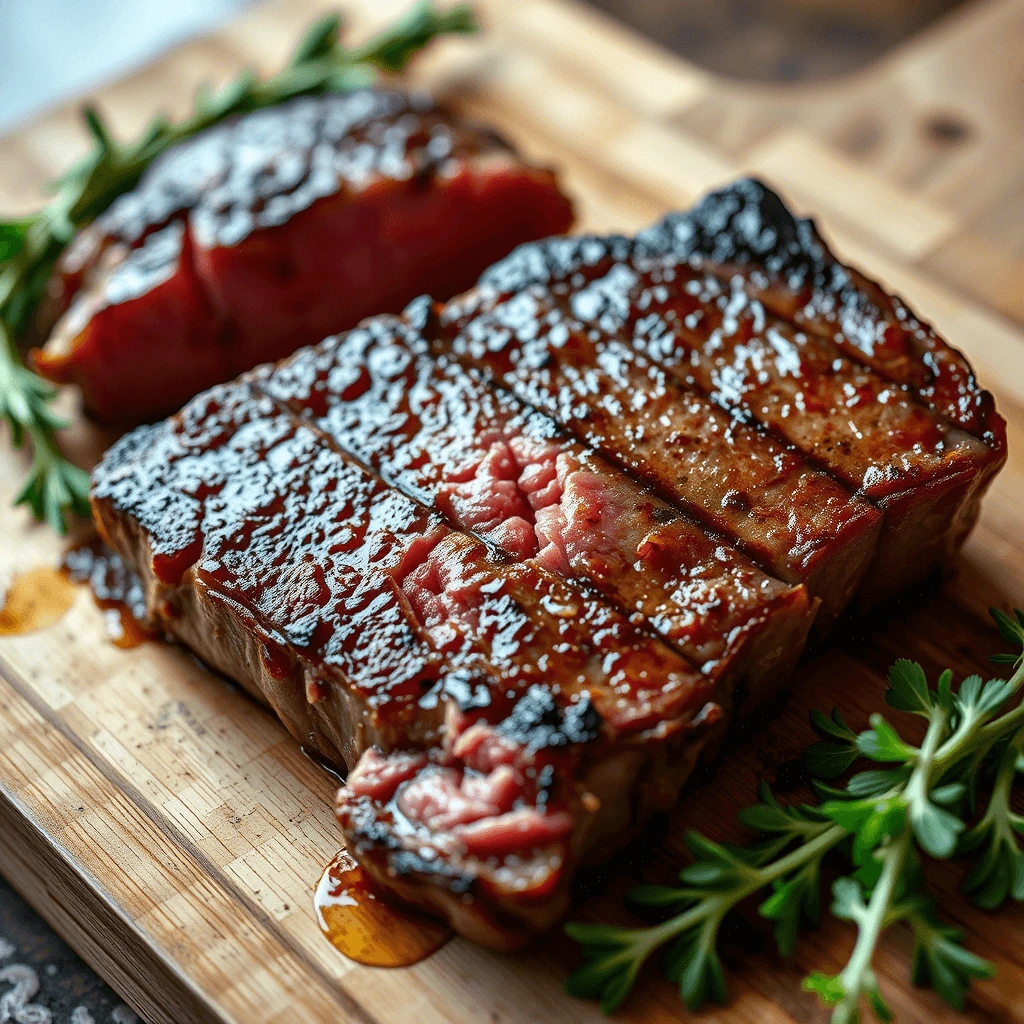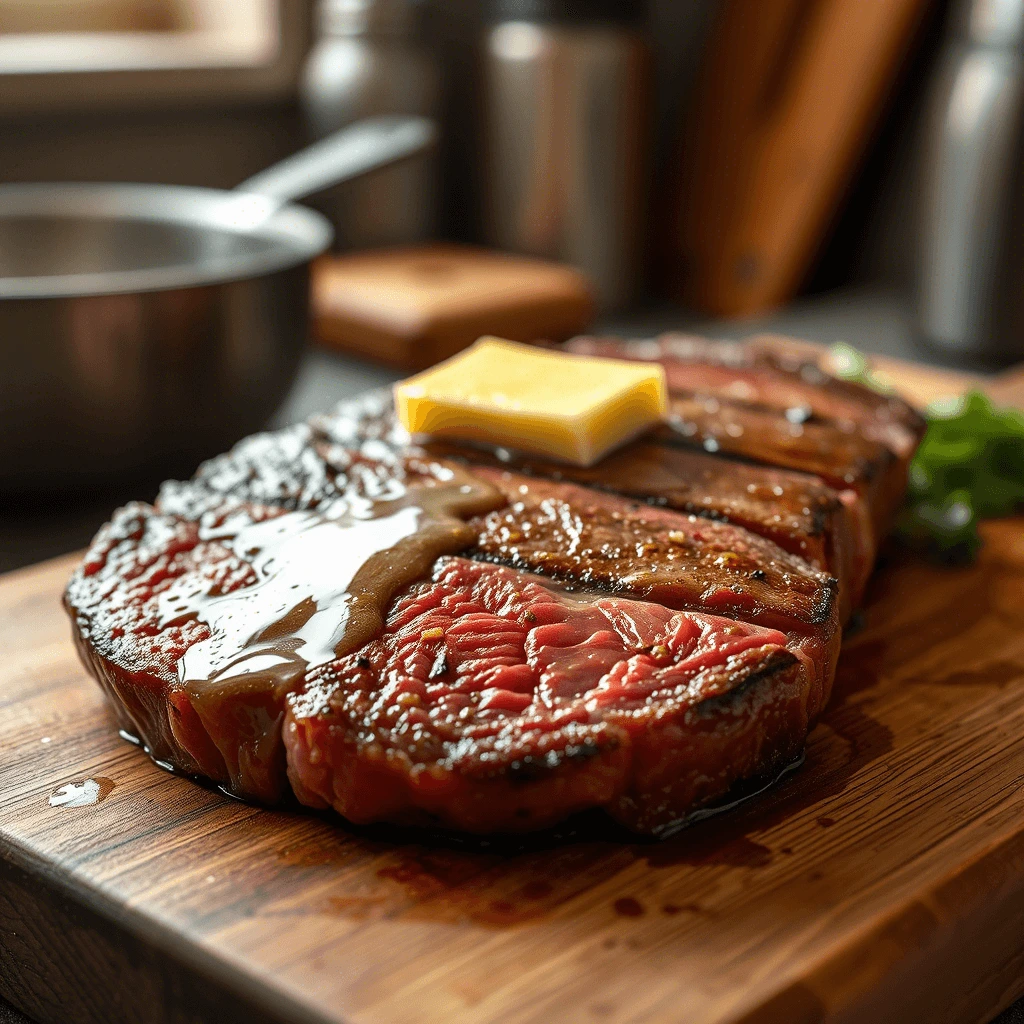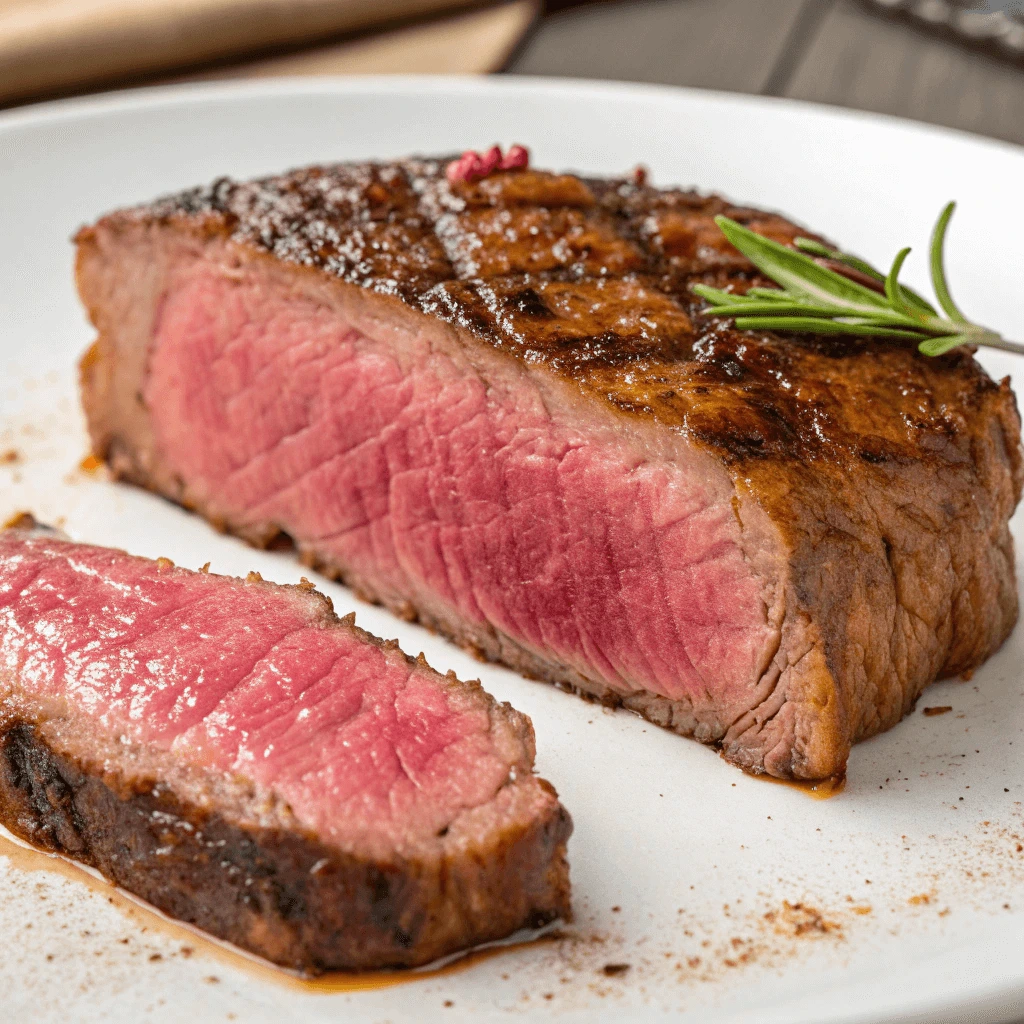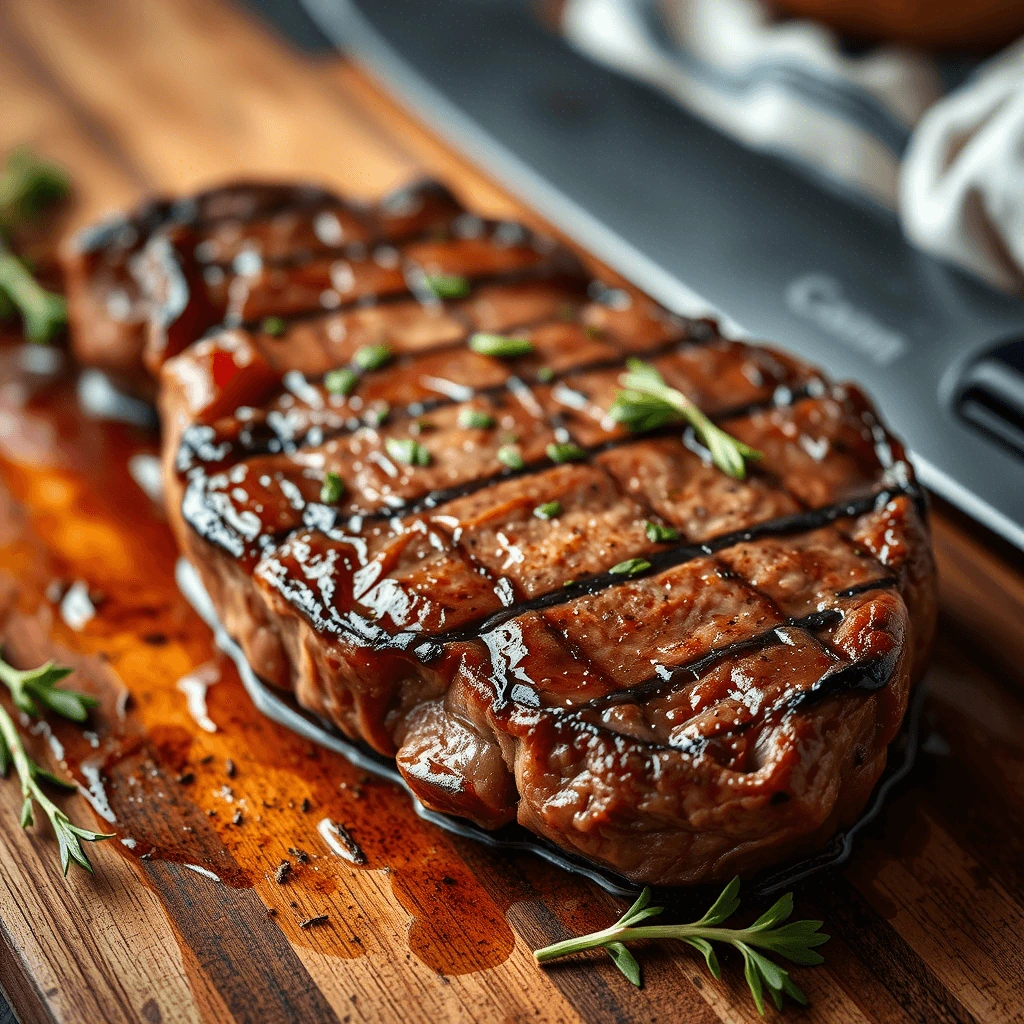There’s nothing quite like the rich, juicy bite of a perfectly cooked rare steak. With its warm red center, tender texture, and bold, beefy flavor, rare steak is a true favorite among meat lovers and steak purists alike. But achieving that ideal doneness at home can seem intimidating—until now. In this post, we’re sharing the best rare steak recipe you’ll ever try, with easy-to-follow steps, simple ingredients, and expert tips to help you cook restaurant-quality steak right in your own kitchen. Whether you’re a seasoned steak lover or just starting to explore different doneness levels, this guide will take your steak game to the next level.
What Makes a Rare Steak So Special?
Rare Steak vs Medium Rare: Know the Difference
When it comes to steak doneness, the terms rare and medium rare are often used interchangeably—but they’re not the same. Understanding the difference between these two levels of doneness is key to cooking a steak that matches your taste and texture preferences.
Temperature & Appearance
A rare steak is cooked to an internal temperature of about 125°F (52°C). It has a cool to warm red center, and the outer layer is just barely seared to form a flavorful crust. The texture is soft and very tender, often described as buttery or velvety.
A medium rare steak, on the other hand, is cooked slightly longer, reaching an internal temperature of 130–135°F (54–57°C). The center is warm and reddish-pink, and the steak is slightly firmer than rare, though still juicy and tender.
Texture & Taste
Rare steaks retain more of the meat’s natural moisture and juices. They offer a delicate chew and a richer, more pronounced beef flavor. Medium rare steaks provide a balance—slightly more cooked, but still succulent with a bit more structure and bite.
Which One Should You Choose?
It depends on your preference. If you love a melt-in-your-mouth experience with maximum juiciness, rare steak is your best bet. If you prefer a bit more warmth and texture without losing tenderness, medium rare might be more satisfying. Either way, both are popular among steak lovers for good reason—and knowing the distinction will help you cook and order your steak with confidence.
Why Chefs (and Carnivores) Prefer Rare Steak
Ask any professional chef or true steak connoisseur, and you’ll likely hear the same thing: rare steak is the purest way to enjoy a quality cut of beef. While doneness preferences vary, rare steak holds a special place in the culinary world for several compelling reasons.
Maximum Juiciness and Natural Flavor
Cooking steak to rare preserves more of its natural juices, which means a more succulent bite. Because the internal temperature doesn’t rise too high, the muscle fibers don’t contract as much, allowing the meat to retain its moisture. This results in a rich, beefy flavor that isn’t masked by overcooking or excessive charring.
Preserves Texture and Tenderness
Rare steak is notably tender because the connective tissues haven’t had time to tighten or break down. This gives it a soft, melt-in-your-mouth feel that’s especially desirable in premium cuts like filet mignon, ribeye, or sirloin. When cooked right, rare steak delivers a delicate balance of crust on the outside and buttery tenderness inside.
Showcases the Quality of the Meat
Top chefs often prefer rare steak because it highlights the quality and character of the beef itself—especially when using well-marbled, grass-fed, or USDA Prime cuts. Overcooking can mask imperfections or dryness, but a rare steak relies on the natural excellence of the meat. It’s a true test of both ingredient and technique, which is why many chefs consider rare the gold standard.
Whether you’re grilling for guests or cooking for yourself, choosing rare steak is a bold yet refined move that honors the integrity of the meat—and elevates the entire dining experience.
Is Rare Steak Safe to Eat? A Quick Guide
One of the most common questions surrounding rare steak is also the most important: is it safe to eat? The short answer is yes—when handled and cooked properly, rare steak can be both delicious and completely safe.
The Science Behind Steak Safety
The main concern with undercooked meat is the potential presence of harmful bacteria like E. coli or Salmonella. However, these bacteria typically live on the surface of the meat, not deep inside. That’s why when cooking a whole cut of beef like a steak, it’s usually safe to cook it rare—as long as the outside is properly seared at high heat, which kills surface bacteria.
This is very different from ground beef, where the meat is mixed and any surface bacteria can be spread throughout. Ground beef should always be cooked to a higher internal temperature (at least 160°F/71°C), but a rare steak only needs to reach around 125°F (52°C) in the center.
Safe Preparation Practices at Home
To reduce any risk when preparing a rare steak at home, follow these basic safety guidelines:
- Buy high-quality, fresh beef from a reputable butcher or grocery store. Look for USDA Prime or Choice cuts if possible.
- Store your steak properly in the fridge and cook it within a few days of purchase.
- Avoid cross-contamination by using clean utensils, cutting boards, and plates.
- Always sear the steak on high heat to kill surface bacteria—this is non-negotiable for rare steaks.
Who Should Avoid Rare Steak?
While most healthy adults can safely enjoy rare steak, certain groups should opt for more well-cooked options. This includes pregnant individuals, young children, elderly adults, and those with compromised immune systems, who are more vulnerable to foodborne illness.
In summary, rare steak is safe to eat when cooked and handled correctly. With a good sear and fresh beef, you can enjoy that juicy, red-centered perfection worry-free.

Ingredients & Tools You’ll Need
Best Cuts for Rare Steak
Choosing the right cut of beef is the first step to achieving a truly delicious rare steak. Not all cuts respond the same way to rare cooking, so selecting a tender, well-marbled piece of meat is key. The best cuts for rare steak are those that are naturally tender and flavorful, requiring minimal cooking time to shine.
1. Filet Mignon (Tenderloin)
Often considered the most tender cut of beef, filet mignon is a top choice for rare steak lovers. It comes from the tenderloin, a muscle that does very little work, which gives it a buttery texture and mild flavor. While it doesn’t have a lot of fat marbling, its tenderness makes it ideal for a rare or even blue-rare preparation.
2. Ribeye
The ribeye is rich, juicy, and packed with intense beef flavor thanks to its generous marbling of fat. That intramuscular fat helps the steak stay moist and flavorful, even when cooked rare. When seared properly, a rare ribeye delivers a mouthwatering crust with a soft, luscious center—making it a favorite among chefs and steak enthusiasts.
3. Sirloin (Top Sirloin)
Top sirloin is a more affordable option that still performs beautifully when cooked rare. It’s leaner than ribeye but has a beefy taste that holds up well with simple seasoning. To make the most of a rare sirloin, be sure not to overcook it, as it can become slightly tougher than more marbled cuts.
Bonus Tip: Choose USDA Grades Wisely
When shopping for steak, look for USDA Prime or USDA Choice grades. These cuts typically offer better marbling and tenderness—both essential for a satisfying rare steak. Grass-fed beef is another great option, known for its leaner profile and distinct flavor, though it may cook slightly faster due to less fat content.
In short, the best cuts for rare steak are ones that don’t need long cooking times to become tender. Stick with filet mignon, ribeye, or top sirloin, and you’ll have the perfect foundation for a rare steak that’s juicy, flavorful, and tender in every bite.
Essential Ingredients for Flavorful Results
While the star of any rare steak recipe is undoubtedly the beef itself, the supporting ingredients can make a huge difference in the final flavor and texture. A great rare steak doesn’t require a long list of fancy ingredients—just a few high-quality, carefully chosen items that enhance the meat’s natural flavor without overpowering it.
1. Sea Salt (or Kosher Salt)
Salt is the single most important seasoning for steak. It draws out moisture and helps create a beautiful crust when seared. Sea salt or kosher salt is preferred over table salt because of its coarser texture and cleaner flavor. Be generous—especially for thick cuts—as the seasoning needs to penetrate the surface to make an impact.
2. Freshly Cracked Black Pepper
Freshly ground black pepper adds a mild heat and subtle complexity to the steak. It complements the savory beef flavors without overwhelming them. Add it just before or after searing, depending on how peppery you want the crust—some chefs prefer to add it after cooking to avoid burning during the sear.
3. Garlic Butter or Herb Butter (Optional but Delicious)
If you want to elevate your rare steak with a rich, gourmet touch, finish it with garlic butter or a compound herb butter. A pat of butter melting over the hot steak as it rests infuses the meat with flavor and gives it a glossy, restaurant-style finish. You can make your own by mixing softened butter with garlic, parsley, rosemary, or thyme.
4. Olive Oil (or Neutral Oil for Searing)
Before searing, lightly coat the steak in olive oil or another high-heat oil like avocado or canola. This helps achieve an even, caramelized crust and prevents sticking. If using olive oil, choose a light or refined version to avoid smoking at high heat.
5. Optional Add-Ins for Extra Flavor
- Crushed garlic cloves or rosemary sprigs in the pan during searing add aromatic flavor.
- A splash of Worcestershire sauce or balsamic glaze during resting can add tangy depth.
- A light dry rub with smoked paprika or mustard powder can boost flavor for thicker cuts.
Keep It Simple, Let the Steak Shine
With rare steak, less is more. The goal is to enhance the beef’s natural taste, not mask it. Using quality salt, freshly ground pepper, and a touch of butter or oil will deliver steakhouse-level flavor without overcomplicating the process.
Must-Have Tools for Perfect Cooking
To cook a rare steak to perfection, you don’t need a full professional kitchen—but having the right tools can make all the difference. From achieving a flawless sear to ensuring accurate doneness, these must-have items will help you replicate steakhouse results in your own home.
1. Cast Iron Skillet
When it comes to searing steak, a cast iron skillet is the gold standard. Its ability to retain and evenly distribute heat ensures a deep, golden-brown crust—something you can’t get with nonstick pans or thin stainless steel cookware. Cast iron also tolerates extremely high temperatures, which is crucial for developing that perfect sear while keeping the center beautifully rare.
Pro tip: Preheat the skillet until it’s smoking hot before adding your steak—this helps seal in juices and creates that coveted crust.
2. Instant-Read Meat Thermometer
Rare steak is all about precision. An instant-read thermometer takes the guesswork out of cooking and ensures your steak reaches the ideal internal temperature of 125°F (52°C). This small tool is a game changer for home cooks, helping you avoid overcooking while hitting your target doneness with confidence.
Look for a digital model with a fast response time, and always insert it into the thickest part of the steak for the most accurate reading.
3. Wire Rack or Resting Plate
After searing, your steak needs to rest for 5–10 minutes to allow the juices to redistribute. Placing it on a wire rack (instead of a flat plate) prevents the bottom from steaming and getting soggy. If you don’t have a rack, use a plate covered loosely with foil, but avoid stacking or wrapping tightly.
Why rest the steak? It locks in moisture and flavor, ensuring every bite is as juicy as the first.
4. Sharp Chef’s Knife (Bonus Tool)
Once rested, slicing your steak with a sharp chef’s knife ensures clean cuts and preserves the presentation. Always slice against the grain for maximum tenderness.
Final Thoughts
Investing in these essential tools—a cast iron skillet, meat thermometer, and resting rack—will dramatically improve your rare steak results. They help you control heat, check for accuracy, and preserve every ounce of flavor, turning a simple recipe into a restaurant-quality experience.

How to Cook the Perfect Rare Steak (Step-by-Step)
Prep and Season Your Steak
Before your rare steak even touches the pan, proper preparation and seasoning are essential to achieving a juicy, flavorful result. This step may seem simple, but small details make a big difference in texture, taste, and overall cooking success. Great steak starts with thoughtful preparation.
1. Bring the Steak to Room Temperature
One of the most overlooked steps in steak prep is letting the meat rest at room temperature for 30–45 minutes before cooking. Taking the chill off allows the steak to cook more evenly, especially when aiming for a rare center. If your steak is too cold when it hits the pan, the outside may sear quickly while the inside stays too raw or uneven.
Tip: Take it out of the fridge and leave it uncovered to reduce moisture on the surface.
2. Pat It Dry with Paper Towels
Before seasoning, make sure to pat the steak completely dry using paper towels. Moisture on the surface of the meat will prevent a proper sear and can cause the steak to steam rather than caramelize. A dry surface means better browning and a crisp, flavorful crust.
Why this matters: A dry steak helps trigger the Maillard reaction, which gives you that beautiful, golden-brown crust.
3. Season Generously—But Simply
When it comes to a great rare steak, less is more. Let the quality of the meat shine with just a few classic seasonings:
- Coarse sea salt or kosher salt: Salt enhances natural beef flavor and helps form a crust.
- Freshly cracked black pepper: Adds a touch of heat and complexity.
- Optional: A light drizzle of olive oil can help seasonings stick and promote even browning.
Be sure to season all sides, including the edges. Don’t be shy—much of the seasoning stays on the surface and some will be lost in the pan, so a generous hand is key.
Optional bonus: You can add a pinch of garlic powder or a few crushed herbs (like rosemary or thyme), but avoid overdoing it—rare steak is all about the pure beef flavor.
Prep Sets the Stage
Properly preparing and seasoning your steak may only take a few minutes, but it sets the foundation for everything that follows. With a dry surface, room-temperature meat, and bold seasoning, you’re now ready to create an unforgettable rare steak with a perfect crust and melt-in-your-mouth center.
Sear It Right in a Cast Iron Skillet
The sear is where the magic happens. This step transforms your well-seasoned, prepped steak into a beautifully caramelized, crusted masterpiece—all while keeping the inside perfectly rare. A cast iron skillet is the ideal tool for this job, thanks to its heat retention and ability to create that iconic steakhouse-quality sear.
1. Preheat Until Smoking Hot
Before adding the steak, let your cast iron skillet preheat for at least 5 minutes over medium-high to high heat. You want it blazing hot—hot enough that a drop of water sizzles and evaporates instantly on contact. This high heat ensures immediate browning and locks in juices by forming a crisp, flavorful crust.
Tip: Don’t rush this step. A properly heated skillet is key to avoiding a gray, steamed steak.
2. Add Oil or Butter for the Sear
Once the pan is hot, add a high smoke point oil such as avocado, grapeseed, or canola oil. These oils can handle intense heat without burning. If you’re adding butter for flavor, do so about halfway through cooking or at the end, as it can burn quickly.
For extra depth of flavor, toss in a crushed garlic clove, a few sprigs of thyme or rosemary, and a small pat of butter toward the end. Tilt the pan and spoon the sizzling butter over the steak for a classic French basting technique (called arroser).
3. Sear Each Side Without Moving It
Place the steak in the center of the pan and don’t move it for at least 1½ to 2 minutes. This allows a golden crust to form. Flip it and do the same on the other side. For a thicker cut, consider quickly searing the sides as well using tongs.
For rare doneness, your steak should cook for:
- 1.5 to 2.5 minutes per side (depending on thickness, typically 1 to 1.5 inches thick).
- You’re aiming for an internal temp of 125°F (52°C). Use an instant-read thermometer for accuracy.
Pro tip: If you like extra crust without overcooking, press the steak gently into the skillet with a spatula during the initial sear.
Why Searing Matters
Searing in a cast iron skillet delivers the rich, deep flavor that only high heat and good beef can create. The browned crust is not just tasty—it’s the result of the Maillard reaction, a chemical process that unlocks complex, savory flavors and a satisfying texture contrast to the tender rare center.
By searing your steak with confidence and care, you’re not just cooking—you’re elevating it to steakhouse quality right in your kitchen.
Check Temperature & Rest the Steak
After achieving that perfect sear, you’re just a few steps away from enjoying a rare steak that’s tender, juicy, and bursting with flavor. But this final phase—checking the internal temperature and allowing the steak to rest—is critical to ensuring your efforts pay off. Skip it, and you risk losing flavor, texture, and consistency.
1. Use a Meat Thermometer to Check Doneness
Cooking rare steak is all about precision. The only way to be sure your steak is truly rare—not raw, and not medium—is to use an instant-read meat thermometer. Insert the probe into the thickest part of the steak, making sure you’re not hitting any bone or fat pockets that could skew the reading.
- Rare steak temperature:
✅ 120–125°F (49–52°C) (Remove from heat at 120°F; it will rise slightly while resting.)
If you prefer to gauge by touch, a rare steak should feel soft and slightly springy when pressed in the center, similar to pressing the fleshy area at the base of your thumb.
Tip: Avoid cutting into the steak to check—this releases precious juices and interrupts the cooking process.
2. Rest the Steak (Don’t Skip This!)
Once your steak hits the target temperature, remove it from the skillet and let it rest on a wire rack or plate for 5 to 10 minutes. This step is absolutely essential—even more so when cooking rare—because it allows the juices, which have rushed to the surface from the high heat, to redistribute throughout the meat.
If you slice the steak too early, those juices will spill out onto the plate, leaving you with a drier, less flavorful bite.
Pro tip: Tent the steak loosely with foil to keep it warm while it rests. Don’t wrap it tightly, or you’ll trap steam and soften the beautiful crust you worked so hard to achieve.
3. Why Resting Improves Taste and Texture
Resting isn’t just a technical step—it enhances flavor, texture, and overall enjoyment. During cooking, the meat’s fibers contract and push juices toward the surface. Resting allows those fibers to relax and reabsorb moisture, making each bite juicy and tender from edge to center.
In short: don’t rush the finish line. A few extra minutes of resting will turn your rare steak from good to unforgettable.


